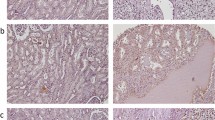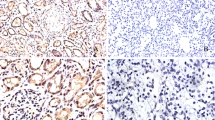Abstract
In cancer therapy novel concepts focus on phosphoinositide-3-kinase/protein kinase B/mammalian target of rapamycin (mTOR) inhibitors. In this context, phosphorylated S6 protein of the 40S ribosomal subunit (pS6) overexpression was previously shown to be associated with sensitivity to inhibitors of mTOR. The present study therefore evaluated pS6 expression in normal renal parenchyma (NRP), primary renal cell carcinomas (PRCC) and their metastases. pS6 and pmTOR expression was immunohistochemically analyzed in a tissue microarray (TMA) from localized primary renal cell carcinoma (lPRCC) (n = 35), metastasized primary renal cell carcinoma (mPRCC) (n = 45), their metastases (n = 45), and NRP (n = 45). pS6 expression was stronger in mPRCCs and metastases than in NRP and lPRCCs (p < 0.05). In mPRCCs high-grade and high-stage tumors showed higher pS6 levels. pS6 overexpression was more frequently found in metastases (40/45; 88.9%) than in mPRCC (24/45; 53.3%) (p < 0.05). Overexpression of pS6 in metastases without concomitant overexpression in their primary tumors was found in 16/45 (35.56%) cases. Patients with pS6 overexpression in mPRCCs but also in metastases showed a tendency to shorter overall survival. pS6 score and pmTOR score correlated positively in NRP and in tumorous tissue (mPRCC and metastases). In conclusion, the present study showed stronger pS6 expression and more frequent overexpression in metastases than in corresponding PRCCs. In approximately one-third of the cases pS6 overexpression was found exclusively in metastases, which is interesting with regard to the association between high pS6 expression and sensitivity to mTOR inhibitor therapy.


Similar content being viewed by others
Abbreviations
- PI3K:
-
Phosphoinositide-3-kinase
- AKT:
-
Protein kinase B
- pAKT:
-
Phosphorylated protein kinase B
- mTOR:
-
Mammalian target of rapamycin
- pS6:
-
S6 protein of the 40S ribosomal subunit
- NRP:
-
Normal renal parenchyma
- PRCC:
-
Primary renal cell carcinoma
- mPRCC:
-
Metastasized primary renal cell carcinoma
- lPRCC:
-
Localized primary renal cell carcinoma
- TMA:
-
Tissue microarray
References
Dufner A, Thomas G (1999) Ribosomal S6 kinase signaling and the control of translation. Exp Cell Res 253:100–109
Ferrari S, Bandi HR, Hofsteenge J et al (1991) Mitogen-activated 70K S6 kinase. Identification of in vitro 40 S ribosomal S6 phosphorylation sites. J Biol Chem 266:22770–22775
Bose S, Chandran S, Mirocha JM et al (2006) The Akt pathway in human breast cancer: a tissue-array-based analysis. Mod Pathol 19:238–245
Cho D, Signoretti S, Dabora S et al (2007) Potential histologic and molecular predictors of response to temsirolimus in patients with advanced renal cell carcinoma. Clin Genitourin Canc 5:379–385
Chow S, Minden MD, Hedley DW (2006) Constitutive phosphorylation of the S6 ribosomal protein via mTOR and ERK signaling in the peripheral blasts of acute leukemia patients. Exp Hematol 34:1183–1191
Cotler SJ, Hay N, Xie H et al (2008) Immunohistochemical expression of components of the Akt-mTORC1 pathway is associated with hepatocellular carcinoma in patients with chronic liver disease. Dig Dis Sci 53:844–849
Iwenofu OH, Lackman RD, Staddon AP et al (2008) Phospho-S6 ribosomal protein: a potential new predictive sarcoma marker for targeted mTOR therapy. Mod Pathol 21:231–237
Pantuck AJ, Seligson DB, Klatte T et al (2007) Prognostic relevance of the mTOR pathway in renal cell carcinoma: implications for molecular patient selection for targeted therapy. Cancer 109:2257–2267
Robb VA, Karbowniczek M, Klein-Szanto AJ et al (2007) Activation of the mTOR signaling pathway in renal clear cell carcinoma. J Urol 177:346–352
Trinh XB, Tjalma WA, Vermeulen PB et al (2009) The VEGF pathway and the AKT/mTOR/p70S6K1 signalling pathway in human epithelial ovarian cancer. Br J Canc 100:971–978
Fresno Vara JA, Casado E, De Castro J et al (2004) PI3K/Akt signalling pathway and cancer. Canc Treat Rev 30:193–204
Hay N, Sonenberg N (2004) Upstream and downstream of mTOR. Gene Dev 18:1926–1945
Hudes G, Carducci M, Tomczak P et al (2007) Temsirolimus, interferon alfa, or both for advanced renal-cell carcinoma. New Engl J Med 356:2271–2281
Kapoor A, Figlin RA (2009) Targeted inhibition of mammalian target of rapamycin for the treatment of advanced renal cell carcinoma. Cancer 115:3618–3630
Merseburger AS, Kuczyk MA (2008) Value of targeted therapies for renal cell cancer. Urologe A 47:1303–1310
Fuhrman SA, Lasky LC, Limas C (1982) Prognostic significance of morphologic parameters in renal cell carcinoma. Am J Surg Pathol 6:655–663
Eble JN, Sauter G, Epstein JI et al (2004) WHO classification of tumours. Tumors of the urinary system and male genital organs. IARC, Lyon, pp 23–34
Campbell L, Jasani B, Edwards K et al (2008) Combined expression of caveolin-1 and an activated AKT/mTOR pathway predicts reduced disease-free survival in clinically confined renal cell carcinoma. Br J Canc 98:931–940
Klatte T, Seligson DB, La Rochelle J et al (2009) Molecular signatures of localized clear cell renal cell carcinoma to predict disease-free survival after nephrectomy. Canc Epidemiol Biomarkers Prev 18:894–900
Amato RJ, Jac J, Giessinger S et al (2009) A phase 2 study with a daily regimen of the oral mTOR inhibitor RAD001 (everolimus) in patients with metastatic clear cell renal cell cancer. Cancer 115:2438–2446
Atkins MB, Hidalgo M, Stadler WM et al (2004) Randomized phase II study of multiple dose levels of CCI-779, a novel mammalian target of rapamycin kinase inhibitor, in patients with advanced refractory renal cell carcinoma. J Clin Oncol 22:909–918
Motzer RJ, Escudier B, Oudard S et al (2008) Efficacy of everolimus in advanced renal cell carcinoma: a double-blind, randomised, placebo-controlled phase III trial. Lancet 372:449–456
Patel PH, Chadalavada RS, Chaganti RS et al (2006) Targeting von Hippel-Lindau pathway in renal cell carcinoma. Clin Canc Res 12:7215–7220
Akcakanat A, Sahin A, Shaye AN et al (2008) Comparison of Akt/mTOR signaling in primary breast tumors and matched distant metastases. Cancer 112:2352–2358
Ljungberg B, Cowan NC, Hanbury DC et al (2010) EAU guidelines on renal cell carcinoma: the 2010 update. Eur Urol 58:398–406
Youssif TA, Fahmy MA, Koumakpayi IH et al (2011) The mammalian target of rapamycin pathway is widely activated without PTEN deletion in renal cell carcinoma metastases. Cancer 117:290–300
Author information
Authors and Affiliations
Corresponding author
Rights and permissions
About this article
Cite this article
Hager, M., Haufe, H., Alinger, B. et al. pS6 Expression in Normal Renal Parenchyma, Primary Renal Cell Carcinomas and their Metastases. Pathol. Oncol. Res. 18, 277–283 (2012). https://doi.org/10.1007/s12253-011-9439-y
Received:
Accepted:
Published:
Issue Date:
DOI: https://doi.org/10.1007/s12253-011-9439-y




